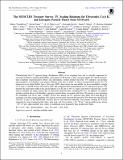The MUSCLES Treasury Survey. IV. Scaling Relations for Ultraviolet, Ca ii K, and Energetic Particle Fluxes from M Dwarfs
Author(s)
Youngblood, Allison; France, Kevin; Loyd, R. O. Parke; Brown, Alexander; Mason, James P.; Schneider, P. Christian; Tilley, Matt A.; Berta-Thompson, Zachory K.; Buccino, Andrea; Froning, Cynthia S.; Hawley, Suzanne L.; Linsky, Jeffrey; Mauas, Pablo J. D.; Redfield, Seth; Kowalski, Adam; Miguel, Yamila; Rugheimer, Sarah; Segura, Antígona; Roberge, Aki; Vieytes, Mariela; Newton, Elisabeth R; ... Show more Show less
DownloadYoungblood_2017_ApJ_843_31.pdf (7.086Mb)
PUBLISHER_POLICY
Publisher Policy
Article is made available in accordance with the publisher's policy and may be subject to US copyright law. Please refer to the publisher's site for terms of use.
Terms of use
Metadata
Show full item recordAbstract
Characterizing the UV spectral energy distribution (SED) of an exoplanet host star is critically important for assessing its planet's potential habitability, particularly for M dwarfs, as they are prime targets for current and near-term exoplanet characterization efforts and atmospheric models predict that their UV radiation can produce photochemistry on habitable zone planets different from that on Earth. To derive ground-based proxies for UV emission for use when Hubble Space Telescope (HST) observations are unavailable, we have assembled a sample of 15 early to mid-M dwarfs observed by HST and compared their nonsimultaneous UV and optical spectra. We find that the equivalent width of the chromospheric Ca ii K line at 3933 Å, when corrected for spectral type, can be used to estimate the stellar surface flux in ultraviolet emission lines, including H i Lyα. In addition, we address another potential driver of habitability: energetic particle fluxes associated with flares. We present a new technique for estimating soft X-ray and > 10 MeV proton flux during far-UV emission line flares (Si iv and He ii) by assuming solar-like energy partitions. We analyze several flares from the M4 dwarf GJ 876 observed with HST and Chandra as part of the MUSCLES Treasury Survey and find that habitable zone planets orbiting GJ 876 are impacted by large Carrington-like flares with peak soft X-ray fluxes ≥10⁻³ W m ⁻² and possible proton fluxes ∼10² -10³ pfu, approximately four orders of magnitude more frequently than modern-day Earth.
Date issued
2017-06Department
MIT Kavli Institute for Astrophysics and Space ResearchJournal
Astrophysical Journal
Publisher
IOP Publishing
Citation
Youngblood, Allison et al. “The MUSCLES Treasury Survey. IV. Scaling Relations for Ultraviolet, Ca ii K, and Energetic Particle Fluxes from M Dwarfs.” The Astrophysical Journal 843, 1 (June 2017): 31 © 2017 The American Astronomical Society
Version: Final published version
ISSN
1538-4357
0004-637X